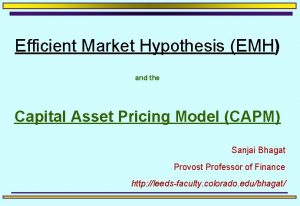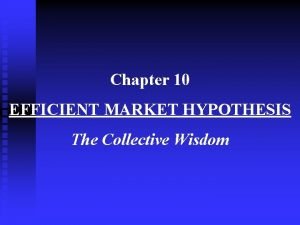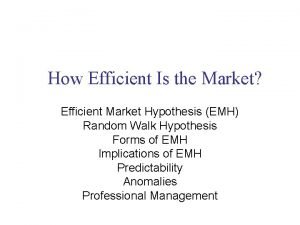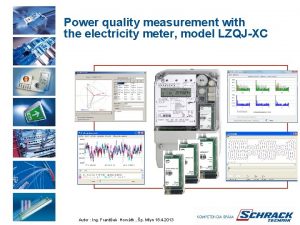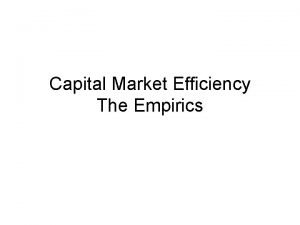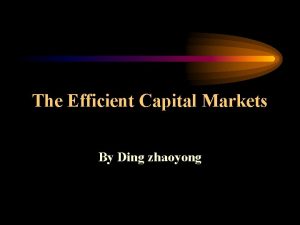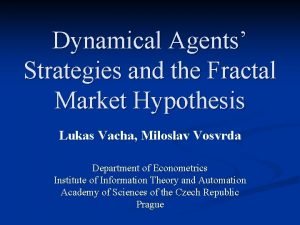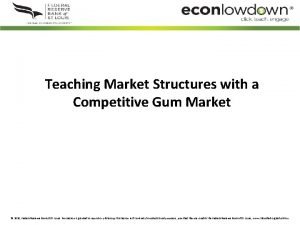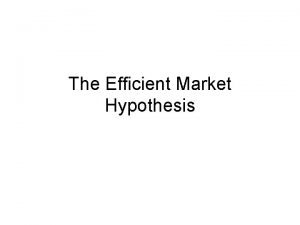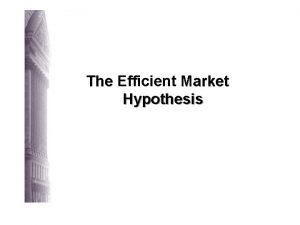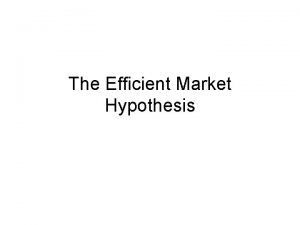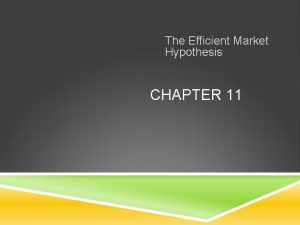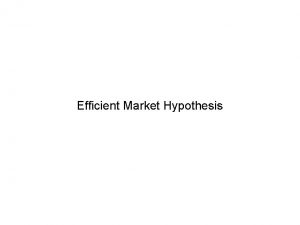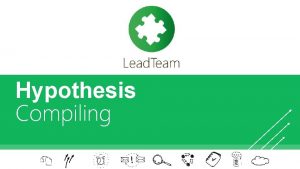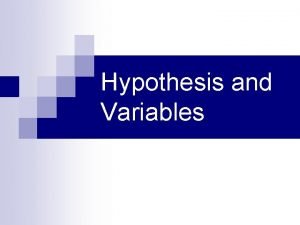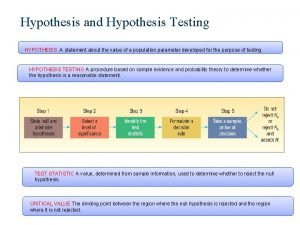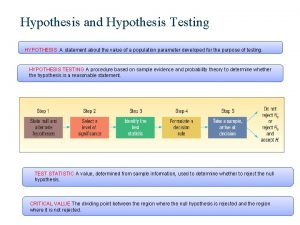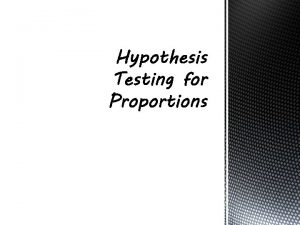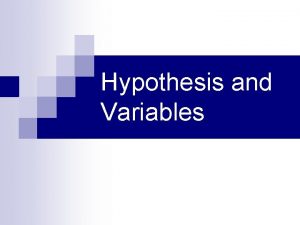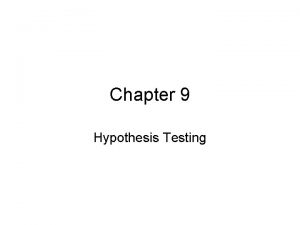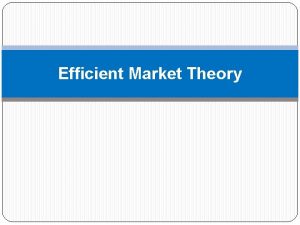The Efficient Market Hypothesis EMH Understand the evidence




































- Slides: 36

The Efficient Market Hypothesis (EMH) Understand the evidence for and against market efficiency Understand the implications of market efficiency for investing and financing decisions

Efficient Capital Markets • An efficient capital market is one in which stock prices fully reflect all available information. • The Efficient Markets Hypothesis (EMH) has implications for investors and firms. – Since information is reflected in security prices quickly, knowing information when it is released does an investor no good. – Firms should expect to receive the fair value for securities that they sell. Firms cannot profit from fooling investors in an efficient market. 20 th Jan 2011 EMH

Review • The EMH says that trying to find patterns in stock prices or trying to find “winners” is a waste of time • The possibility of making excess profits in the stock markets is as rare as finding a sum of money on the street – If a sum of money is lost it will be picked up by somebody very quickly • In the very same way an opportunity to make excess profits will be taken up very quickly, so that no such opportunity will exist for long 20 th Jan 2011 EMH 3

Forms of market efficiency • There are three forms of market efficiency. Markets are either: Ø Weak form efficient Ø Semi-strong form efficient Ø Strong form efficient • The distinction between these three forms of market efficiency depends on the level of information incorporated into the stock price 20 th Jan 2011 EMH 4

Weak form efficiency • If markets were weak form efficient, then all historical information would be reflected in the stock price • it is not possible to make excess returns by using historical information such as company reports, past prices, or any other information that is readily available on the company • Investor would no be able to benefit from this type of information because it is readily available and doesn’t cost very much 20 th Jan 2011 EMH 5

Weak Form • Selecting stocks based on historical information would be of no use to investors. – The fact that a share price might have risen for the past four days, does not give us any information about how the stock price will perform on the fifth day • Analysts who plot past price movements are called “Chartists” • If you believe that weak form efficiency exists, then you believe that chartists are wasting their time – E. G. If a chartist finds a pattern which shows that if a stock price falls for three consecutive days and then rises by 5% on the fourth day, investors could make money by buying stock that fall for three consecutive days • However no investor would sell a stock that had fallen for three consecutive days if she thinks that it will rise in price the following day 20 th Jan 2011 EMH 6

Weak Form • In fact if the share price is € 10 on the third day and if it is expected to rise by 5% on the fourth day, the share price would probably rise to € 10. 50 on the third day, which will eliminate the opportunity for excess profits 20 th Jan 2011 EMH 7

Why Technical Analysis Fails Stock Price Investor behavior tends to eliminate any profit opportunity associated with stock price patterns. If it were possible to make big money simply by finding “the pattern” in the stock price movements, everyone would do it and the profits would be competed away. Sell Buy Time 20 th Jan 2011 EMH

Semi-strong form efficiency • Markets are said to be semi-strong form efficient if no excess returns can be made using publicly available information. • The semi-strong form of the EMH indicates that market prices reflect all publicly available information. • Excess returns cannot be earned by looking at annual reports or any other published data because all such information, good or bad would have been incorporated into the share price when the information became available 20 th Jan 2011 EMH 9

Semi Strong Form • However, any information that is not made available to the public such as that held by company insiders (e. g. directors) can be used to earn excess returns under semistrong form efficiency. • In addition, stock prices will be affected by information that becomes available if the information is different to what was expected • For example, if the company reports a 10% increase in after-tax earnings, the share price won’t be affected by this news if that is what the market was expecting 20 th Jan 2011 EMH 10

Semi Strong Form • On the other hand, if the market was expecting an earnings increase of an amount greater than 10%, then the share price will drop and the share price will rise if the increase in earnings was greater than 10% 20 th Jan 2011 EMH 11

Strong form efficiency • In strong form efficient markets, all information, public and private is reflected in the share price • Incorporating all private information would seem to be difficult • Some information, like a company’s sales figures may only be known to the directors of the company 20 th Jan 2011 EMH 12

Strong Form • If this information is not divulged, then it does not seem possible for the market to incorporate this information into share price. • It might be possible to observe if there was any buying or selling of company shares by insiders acting on privately held information • If a strong form of market efficiency exists, even insider information cannot be used to earn excess returns 20 th Jan 2011 EMH 13

Efficient Markets: the Evidence • In the years that followed Maurice Kendall’s discovery, financial journals were packed with tests of the EMH 20 th Jan 2011 EMH 14

Testing Weak Form • To test weak form efficiency • Researchers measured the profitability of some of the trading rules used by technical analysts, who claim to find patterns in security prices • They also used statistical tests – IT APPEARS THAT THROUGHOUT THE WORLD THERE ARE FEW PATTERNS IN WEEK-TO-WEEK RETURNS 20 th Jan 2011 EMH 15

Testing Semi Strong • To test the semi-strong form • Researchers have measured how rapidly security prices respond to different types of news, such as dividend or earnings announcements, news of takeovers, or macroeconomic news – Any new publicly available information gets instantaneously incorporated into security prices and there is no chance to profit from the information 20 th Jan 2011 EMH 16

Testing Semi Strong • The type of methods used by investment analysts vary in their degree of sophistication: • Some prefer to use simple models based upon looking at data such as E. P. S and Gordan’s growth model, others resort to complex econometric models • The semi-strong form of market efficiency leaves open the possibility for those with privileged inside information to make abnormal profits 20 th Jan 2011 EMH 17

Testing Strong Form • To test the strong-form • The strong form of market efficiency implies that even those with access to privileged inside information will not be able to profit from that information since it is already incorporated into a security’s price 20 th Jan 2011 EMH 18

Testing Strong Form • If it were to hold, then there would be no need for security houses to have “Chinese walls” whereby pricesensitive information from one part of the business is kept from the dealing/brokerage arm of the organization, and there would also be no need for government’s to have “insider trading laws” 20 th Jan 2011 EMH 19

The Evidence • The record on the EMH is extensive, and in large measure it is reassuring to advocates of the efficiency of markets. • Studies fall into three broad categories: 1. Are changes in stock prices random? Are there profitable “trading rules”? 2. Event studies: does the market quickly and accurately respond to new information? 3. The record of professionally managed investment firms. 20 th Jan 2011 EMH 13 -20

Are Stock Prices Changes Random? • Can we really tell? – Many psychologists and statisticians believe that most people want to see patterns even when faced with pure randomness. – People claiming to see patterns in stock price movements are probably seeing optical illusions. • A matter of degree – Even if we can spot patterns, we need to have returns that beat our transactions costs. • Random stock price changes support weak-form efficiency. 20 th Jan 2011 EMH 13 -21

Event Studies: How Tests Are Structured · Event Studies are one type of test of the semi-strong form of market efficiency. ü This form of the EMH implies that prices should reflect all publicly available information. · To test this, event studies examine prices and returns over time—particularly around the arrival of new information. · Test for evidence of under reaction, overreaction, early reaction, delayed reaction around the event. 20 th Jan 2011 EMH

How Tests Are Structured (cont. ) • Returns are adjusted to determine if they are abnormal by taking into account what the rest of the market did that day. • The Abnormal Return on a given stock for a particular day can be calculated by subtracting the market’s return on the same day (RM) from the actual return (R) on the stock for that day: AR= R – RM • The abnormal return can be calculated using the Market Model approach: AR= R – (a + b. RM) 20 th Jan 2011 EMH

Event Studies: Dividend Omissions Efficient market response to “bad news” S. H. Szewczyk, G. P. Tsetsekos, and Z. Santout “Do Dividend Omissions Signal Future Earnings or Past Earnings? ” Journal of Investing (Spring 1997) 20 th Jan 2011 EMH

Event Study Results • Over the years, event study methodology has been applied to a large number of events including: – – – Dividend increases and decreases Earnings announcements Mergers Capital Spending New Issues of Stock • The studies generally support the view that the market is semistrong-from efficient. • In fact, the studies suggest that markets may even have some foresight into the future—in other words, news tends to leak out in advance of public announcements. 20 th Jan 2011 EMH

Issues in Examining the Results • • Magnitude Issue Selection Bias Issue Lucky Event Issue Possible Model Misspecification 20 th Jan 2011 EMH

The Strong Form of the EMH • One group of studies of strong-form market efficiency investigates insider trading. • A number of studies support the view that insider trading is abnormally profitable. • Thus, strong-form efficiency does not seem to be substantiated by the evidence. 20 th Jan 2011 EMH

Views Contrary to Market Efficiency • Stock Market Crash of 1987 – The market dropped between 20 percent and 25 percent on a Monday following a weekend during which little surprising information was released. • Temporal Anomalies – Turn of the year, —month, —week. • Speculative Bubbles – Sometimes a crowd of investors can behave as a single squirrel. 20 th Jan 2011 EMH 13 -28

Empirical Challenges to Market Efficiency (anomalies) • Crashes – On October 19, 1987 the stock market dropped between 20 and 25 percent on a Monday following a weekend during which little surprising news was released. – A drop of this magnitude for no apparent reason is inconsistent with market efficiency. • Bubbles – Consider the tech stock bubble of the late 1990 s. 20 th Jan 2011 EMH 13 -29

Reviewing the Differences • Financial Economists have sorted themselves into three camps: 1. Market efficiency 2. Behavioral finance 3. Those that admit that they don’t know • This is perhaps the most contentious area in the field. 20 th Jan 2011 EMH 13 -30

Implications for Corporate Finance • Because information is reflected in security prices quickly, investors should only expect to obtain a normal rate of return. – Awareness of information when it is released does an investor little good. The price adjusts before the investor has time to act on it. • Firms should expect to receive the fair value for securities that they sell. – Fair means that the price they receive for the securities they issue is the present value. – Thus, valuable financing opportunities that arise from fooling investors are unavailable in efficient markets. 20 th Jan 2011 EMH

Implications for Corporate Finance • The EMH has three implications for corporate finance: – The price of a company’s stock cannot be affected by a change in accounting. – Financial managers cannot “time” issues of stocks and bonds using publicly available information. – A firm can sell as many shares of stocks or bonds as it desires without depressing prices. • There is conflicting empirical evidence on all three points. 20 th Jan 2011 EMH

Why Doesn’t Everybody Believe the EMH? • There are optical illusions, mirages, and apparent patterns in charts of stock market returns. • The truth is less interesting. • There is some evidence against market efficiency: – Seasonality – Small versus Large stocks – Value versus growth stocks • The tests of market efficiency are weak. 20 th Jan 2011 EMH

Some Common Misconceptions • Much of the criticism of the EMH has been based on a misunderstanding of what the hypothesis says and does not say. 20 th Jan 2011 EMH

What the EMH Does and Does NOT Say • Investors can throw darts to select stocks. – This is almost, but not quite, true. – An investor must still decide how risky a portfolio he wants based on risk aversion and the level of expected return. • Prices are random or uncaused. – Prices reflect information. – The price CHANGE is driven by new information, which by definition arrives randomly. – Therefore, financial managers cannot “time” stock and bond sales. 20 th Jan 2011 EMH

Summary and Conclusions • An efficient market incorporates information in security prices. • There are three forms of the EMH: – Weak-Form EMH • Security prices reflect past price data. – Semistrong-Form EMH • Security prices reflect publicly available information. – Strong-Form EMH • Security prices reflect all information. • There is abundant evidence for the first two forms of the EMH. 20 th Jan 2011 EMH
 Evidence supporting efficient market hypothesis
Evidence supporting efficient market hypothesis Efficient markets theory
Efficient markets theory Efficient market hypothesis
Efficient market hypothesis Efficient market hypothesis
Efficient market hypothesis The efficient market hypothesis suggests that _______.
The efficient market hypothesis suggests that _______. ø-market value meaning
ø-market value meaning Emh lzqj-xc
Emh lzqj-xc Magnitude issue emh
Magnitude issue emh Productively efficient vs allocatively efficient
Productively efficient vs allocatively efficient Productively efficient vs allocatively efficient
Productively efficient vs allocatively efficient Productively efficient vs allocatively efficient
Productively efficient vs allocatively efficient Productively efficient vs allocatively efficient
Productively efficient vs allocatively efficient Allocative efficiency vs productive efficiency
Allocative efficiency vs productive efficiency To understand recursion you must understand recursion
To understand recursion you must understand recursion Market leader follower challenger nicher
Market leader follower challenger nicher Benefits of market segmentation targeting and positioning
Benefits of market segmentation targeting and positioning The following are advantages of the sml approach
The following are advantages of the sml approach Characteristics of an efficient market
Characteristics of an efficient market Efficient elements alternative
Efficient elements alternative An efficient capital market is one in which
An efficient capital market is one in which Define null hypothesis
Define null hypothesis Alternative hypothesis
Alternative hypothesis Null hypothesis examples
Null hypothesis examples Weakness of protoplanet hypothesis
Weakness of protoplanet hypothesis Out of africa hypothesis evidence
Out of africa hypothesis evidence What is primary sources
What is primary sources Primary evidence vs secondary evidence
Primary evidence vs secondary evidence Secondary sources
Secondary sources Primary evidence vs secondary evidence
Primary evidence vs secondary evidence Primary evidence vs secondary evidence
Primary evidence vs secondary evidence Fiber evidence can have probative value as class evidence.
Fiber evidence can have probative value as class evidence. Class evidence vs individual evidence
Class evidence vs individual evidence Class evidence can have probative value
Class evidence can have probative value A pair of latex gloves was found at a crime scene
A pair of latex gloves was found at a crime scene Appeal to pity examples
Appeal to pity examples Fractal market hypothesis
Fractal market hypothesis Teaching market structures with a competitive gum market
Teaching market structures with a competitive gum market


